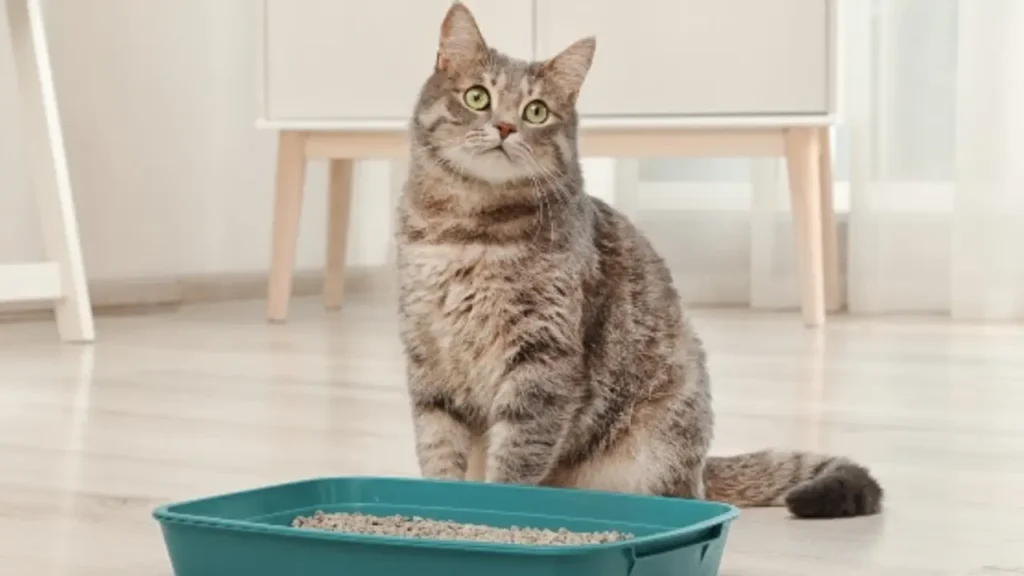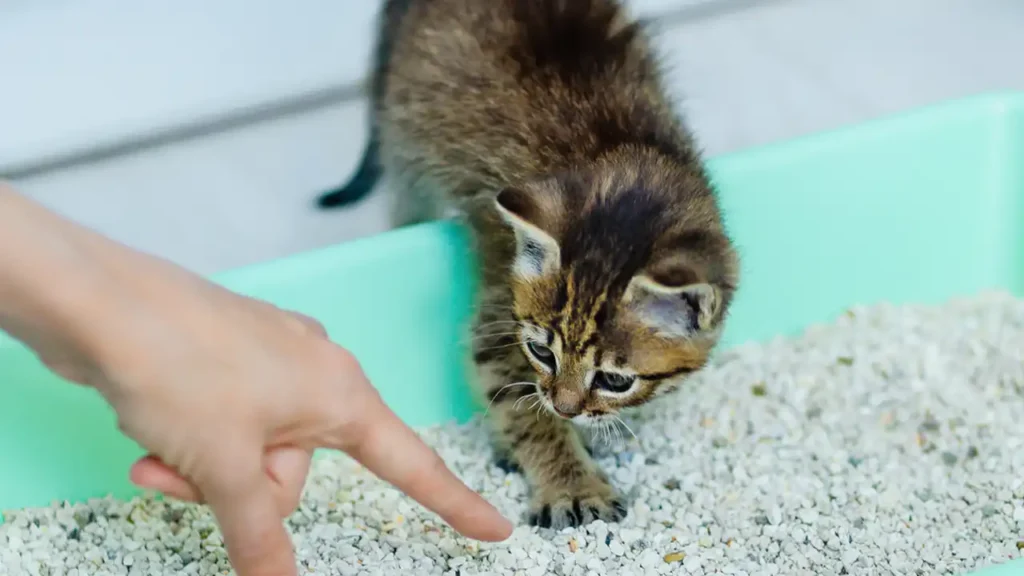Is your feline friend suddenly avoiding the litter box? This can be a frustrating and confusing experience for cat owners. Understanding the reasons behind this behavior can help you address the issue effectively and maintain a harmonious relationship with your cat.
In this blog post, we’ll explore the common causes of cats not using their litter boxes and provide practical solutions to help you resolve the problem.
Why is My Cat Not Using the Litter Box

If your feline friend has suddenly stopped using the litter box, it can be a frustrating and confusing experience. Understanding the underlying causes can help you address the issue effectively and maintain a harmonious relationship with your cat.
Here are some common reasons why cats may avoid their litter boxes:
Litter Box Issues:
- Litter Box Size: The box might be too small for your cat to move around in comfortably.
- Litter Type: Some cats prefer certain types of litter over others. Experiment with different options to find what works best for your cat.
- Litter Box Location: The box might be in a noisy or high-traffic area, making your cat feel uncomfortable.
- Box Cleanliness: Cats are very clean animals and may avoid a dirty litter box. Make sure to clean the box regularly and scoop out solid waste daily.
Medical Problems:
- Urinary Tract Infections (UTIs): UTIs can cause pain and discomfort when urinating, leading cats to seek out other places.
- Kidney Disease: Kidney disease can affect a cat’s ability to control their bladder.
- Constipation: Difficulty passing stools can make it painful for cats to use the litter box.
- Arthritis: Arthritis can make it difficult for older cats to get in and out of the litter box.
Behavioral Issues:
- Stress or Anxiety: Changes in the environment, new pets, or loud noises can cause stress and anxiety, leading to behavioral changes.
- Territorial Marking: Unneutered or unspayed cats may mark their territory by urinating outside the litter box.
If your cat is consistently avoiding the litter box, it’s important to consult with a veterinarian to rule out any underlying medical issues. Once medical problems are addressed, you can focus on behavioral or environmental factors.
New Cat Not Using Litter Box
It’s not uncommon for a new cat to have trouble adjusting to their new environment and using the litter box. Here are some tips to help your new feline friend transition smoothly:
Litter Box Setup:
- Number of Boxes: For multiple cats, provide at least one litter box per cat plus one extra.
- Location: Place the litter boxes in quiet, private areas away from food and water sources.
- Box Size: Ensure the boxes are large enough for your cat to comfortably stretch and turn around.
- Litter Type: Experiment with different litter types to find one your cat prefers.
Medical Check-up:
- Rule out health issues: A veterinarian can check for any underlying medical conditions that might be causing the problem.
Behavioral Strategies:
- Positive Reinforcement: Reward your cat with treats or praise when they use the litter box.
- Create a Calm Environment: Provide hiding places, scratching posts, and toys to reduce stress.
- Temporary Confinement: If the problem persists, temporarily confine your cat to a small area with the litter box.
Additional Tips:
- Introduce Gradually: If you have other cats, introduce them slowly to minimize stress.
- Clean Thoroughly: Clean any areas where your cat has urinated outside the litter box to prevent accidents from happening again.
- Consult a Veterinarian or Behaviorist: If the problem continues, seek professional advice.
Remember, patience is key. It may take some time for your new cat to adjust to their new home and litter box. By following these tips and providing a supportive environment, you can help your cat transition smoothly and avoid litter box problems in the future.
How to Discipline a Cat for Not Using Litter Box
I strongly advise against disciplining your cat for not using the litter box. Punishment can often lead to increased stress, anxiety, and behavioral problems, including more frequent accidents.
Instead, focus on understanding the underlying causes and implementing positive reinforcement strategies.
Here are some effective approaches:
1. Rule Out Medical Issues:
- Consult a veterinarian: Ensure there are no underlying health problems that might be causing your cat discomfort or difficulty using the litter box.
2. Optimize Litter Box Conditions:
- Size and Location: Ensure the litter box is large enough and placed in a quiet, private area.
- Cleanliness: Clean the box regularly and scoop out solid waste daily.
- Litter Type: Experiment with different litter types to find one your cat prefers.
3. Address Behavioral Issues:
- Identify Stressors: Look for changes in the environment, new pets, or loud noises that might be causing stress.
- Create a Calming Environment: Provide hiding places, scratching posts, and toys to reduce anxiety.
- Positive Reinforcement: Reward your cat with treats or praise when they use the litter box.
4. Provide Additional Support:
- Temporary Confinement: If the problem persists, temporarily confine your cat to a small area with the litter box.
- Consult a Professional: If you’re struggling to resolve the issue, consider consulting with a veterinarian or feline behaviorist.
Remember: Punishment can be counterproductive and harmful to your cat’s well-being. By focusing on understanding and addressing the root causes, you can create a positive and supportive environment that encourages your cat to use the litter box consistently.
How to Train a Cat to Use Cat Litter

Training a cat to use the litter box is generally not necessary, as most cats instinctively understand its purpose. However, if you have a kitten or a cat that’s new to your home, here are some tips to help them acclimate:
Setting Up the Litter Box:
- Placement: Place the litter box in a quiet, private area away from food and water sources.
- Size: Ensure the box is large enough for your cat to comfortably move around in.
- Litter Type: Experiment with different litter types to find one your cat prefers.
- Cleanliness: Clean the box regularly and scoop out solid waste daily.
Introducing Your Cat to the Litter Box:
- Show and Tell: Gently guide your cat to the litter box and show them how to use it.
- Positive Reinforcement: Reward your cat with treats or praise when they use the litter box.
- Patience: It may take a few days for your cat to adjust to the new environment and learn to use the litter box.
Troubleshooting:
- Medical Issues: If your cat is still having trouble, consult with a veterinarian to rule out any underlying health problems.
- Stress or Anxiety: Ensure your cat feels safe and comfortable in their new home.
- Litter Box Problems: Double-check that the litter box is clean, in a suitable location, and using a litter type your cat prefers.
Remember: Most cats will naturally gravitate towards the litter box, especially if it’s clean and in a peaceful location. If you’re having trouble, be patient and consistent with your training efforts.
Would you like to know more about specific litter box problems or how to handle a cat that’s already having issues with the litter box?
Conclusion
Understanding why your cat might be avoiding the litter box is the first step to resolving the issue. By carefully considering the factors discussed in this blog post, such as litter box conditions, medical problems, and behavioral issues, you can identify the root cause and take appropriate action.
Remember, patience and understanding are key. With a little effort and the right approach, you can help your cat return to using the litter box as intended.
Are you struggling to find the perfect litter for your cat? Our wholesale cat litter offers a variety of high-quality options to suit your cat’s needs and preferences. Contact us today to learn more and place your order.
Let’s work together to create a happy and litter box-friendly environment for your feline friend.









